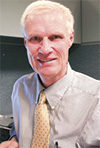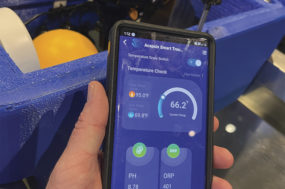My colleague and good friend June Grabemeyer, our Michigan NRCS state economist, and I recently visited a lovely dairy farm in northern Michigan. Here is a trip report.
We had visited this farm before, except snow was on the ground, so looking at crop fields did not tell us very much. And this visit was different.
One of our technical service providers, a young man seeking certification for comprehensive nutrient-management planning (CNMP), was finishing his work and asked us to evaluate his effort before asking for the landowner’s signature.
Interesting how this works. We (NRCS) contract out the development of CNMPs, and technical service providers (TSPs) fill that contract. Nearly all of them are in the private sector.
The TSP program is based on knowledge, skills and abilities, with the ability part manifest by submitting CNMPs to us (NRCS) at the state office. We review them, complete a farm site visit and then agree the plan meets our criteria, or it does not.
If not, the plan review includes a list of items that need more work; the planner (TSP) completes these, and the CNMP is accepted at the field office. Payment is issued to the landowner, and he in turn pays the planner.
In this particular case, this young man is working for a certified planner, but he is seeking his own certification.
In NRCS, we view the TSP as a positive program … those in the private sector with various knowledge and skills can do the field work, including working with the landowner; our role is quality assurance and, of course, contracting those items for payment using the Environmental Quality Incentive Program (EQIP).
For years, my primary NRCS role has been to train folks to write CNMPs, review their work for quality assurance and make sure our fiduciary responsibility is met. That is, the taxpayers are getting a return on the CNMP investment.
I have written often that the return on investment is directly related to the implementation of the CNMP done by the landowner. We do not implement it. The landowner does by following the guidance and courses of action listed in the schedule of implementation.
On this particular day, we are walking on the production area site. The landowners, a father and son, are talking about what is here now and what they have planned in the future. We are particularly interested in their comments.
By listening to what they say, we understand their goals and objectives. June is our lead here in the social science portion of conservation planning, and so she got a field perspective of its importance.
Some landowners talk willingly about their farms and the future of the farm. Some do not. Some landowners talk willingly about the farm family. Some do not.
One of the challenges all planners have is engaging so the landowner willingly talks about both the family farm, the physical attributes of the production area site (headquarters) and the crop or pasture land, and the very important farm family … the family members themselves. Even the ones not on the farm but that have some role in the farm or will in the future.
One of our challenges is that unlike the physical environment (the family farm), we do not have software that we can place inventory to properly account for the human environment, which is the farm family. The social sciences portion of our work is more art and understanding.
To tackle this social science component, we ask Ms. Gail Brant out of Pennsylvania NRCS (duty station is Greensboro, North Carolina) to help us. She is a rural sociologist with a lot of insight into how we may better train our own staff and TSPs, just like the one here with us today.
We now have a list of 10 or so questions the planner can use to help guide them through the discussion. No, they are not mandatory. They are, however, a list of what we suggest are the important questions that help the planner understand the farm family.
This is the work of extension as well. Building a relationship over years of work with a farm family is hugely valuable; we are suggesting that whenever possible, the planner should have this type of engagement during the implementation phase. In fact, I submit it is essential.
Note here that I do not write about the technical aspects of CNMP development. From my perspective, these are readily available. Or if not, we dial in the phone number of a person who can answer a question or offer to help.
It is so important to understand the role of the planner to reach out for help or reach back to his or her network of technical people.
No landowner is well served by the planner attempting to answer every technical question only to find out later, during a quality-assurance review, the engineer found a mistake or the conservationist found a series of mistakes. Not good.
During our visit today, the landowner asked a question about fuel storage and the distance to a public well. We called the engineer, who in turn referred us to the Department of Agriculture official that is the source for answering this question. We had them on speakerphone, so while everyone was in one place, we got an answer.
During my overseas deployments, I often write about the human environment … its importance in what we call capacity building. Capacity building is all about listening. In fact, I suggest that it is the most important role we play.
Here on a dairy farm, the suggestion is appropriate. If we are bullying our way through the planning process because we think we have it all figured out without listening to the landowner, we all lose.
The outcome we (NRCS) seek is not just development of the CNMP, it is the change in human behavior brought about by the landowner willingly and eagerly implementing the items in the CNMP that will enhance the environment, help make the farm more efficient and improve the economic parameters of the farm.
The CNMP is just an output – a necessary one, yes. But it must be written so the landowner does the implementing after we all leave the driveway.
My premise here is this: We must account for the goals and objectives of the farm family, the landowner and the people that operate this farm and will operate it in the future.
Failure to do this essential step skips the social science portion of planning, misses the opportunity to properly engage with and account for the thinking of those owning the farm, and of course, fail to provide a return on investment for developing the CNMP.
In other words, today on a beautiful dairy farm near Charlevoix, Michigan, we listened. PD

Mike Gangwer
Agricultural Scientist
USDA-NRCS




